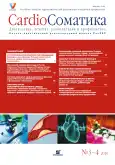Prognostic factors of cardiovascular death in patients with ischemic stroke in the long-term follow up
- Authors: Fonyakin A.V1, Geraskina L.A1, Shandalin V.A1
-
Affiliations:
- Research Center of Neurology
- Issue: Vol 7, No 3-4 (2016)
- Pages: 97-103
- Section: Articles
- URL: https://journals.rcsi.science/2221-7185/article/view/45258
- DOI: https://doi.org/10.26442/CS45258
- ID: 45258
Cite item
Full Text
Abstract
Full Text
##article.viewOnOriginalSite##About the authors
A. V Fonyakin
Research Center of Neurology
Email: Fonyakin@mail.ru
д-р мед. наук, проф., рук. лаб. кардионеврологии 2-го неврологического отд-ния ФГБНУ НЦН 125367, Russian Federation, Moscow, Volokolamskoe sh., d. 80
L. A Geraskina
Research Center of Neurologyд-р мед. наук, вед. науч. сотр. лаб. кардионеврологии 2-го неврологического отделения ФГБНУ НЦН 125367, Russian Federation, Moscow, Volokolamskoe sh., d. 80
V. A Shandalin
Research Center of Neurologyканд. мед. наук, науч. сотр. лаб. кардионеврологии 2-го неврологического отд-ния ФГБНУ НЦН 125367, Russian Federation, Moscow, Volokolamskoe sh., d. 80
References
- Murray C.J, Lopez A.D. Global mortality, disability, and the contribution of risk factors: Global Burden of Disease Study. Lancet 1997; 349: 1436-42.
- Суслина З.А. Сосудистая патология головного мозга: итоги и перспективы. Анналы клин. и эксперим. неврологии. 2007; 1: 10-6.
- Hardie K, Hankey G.J, Jamrozik K et al. Ten - year survival after first - ever stroke and related prognostic factors in the Perth Community stroke study. Stroke 2003; 34: 1842-6.
- Dhamoon M.S, Tai W, Boden-Albala B et al. Risk of myocardial infarction or vascular death after first ischemic stroke. Stroke 2007; 38: 1752-8.
- Sacco R/L, Shi T, Zamanillo M.C, Kargman D.E. Predictors of mortality and recurrence after hospitalized cerebral infarction in an urban community: the Northern Manhattan Stroke Study. Neurology 1994; 44: 626-34.
- Kernan W.N, Ovbiagele B, Black H.R et al. Guidelines for the Prevention of Stroke in Patients with Stroke and Transient Ischemic Attack. A Guideline for Healthcare Professionals from the American Heart Association/American Stroke Association. Stroke 2014; 45: 2160-236.
- Верещагин Н.В., Суслина З.А., Гераскина Л.А., Фонякин А.В. Антигипертензивная терапия при сосудистой патологии мозга: успехи, спорные и нерешенные вопросы. Кремлевская медицина. Клин. вестн. 2003; 2: 7-10.
- Кулеш С.Д., Лихачев С.А., Филина Н.А. и др. Пятилетняя выживаемость после мозгового инсульта. Анналы клин. и эксперим. неврологии. 2012; 1: 14-9.
- Pendlebury S.T, Rothwell P.M. Risk of recurrent stroke, other vascular events and dementia after transient ischemic attack and stroke. Cerebrovasc Dis 2009; 27 (Suppl. 3): 1-11.
- Рябова В.С. Отдаленные последствия мозгового инсульта (по материалам регистра). Журн. невропатол. и психиатр. им. С.С.Корсакова 1986; LXXXVI (Вып. 4): 532-6.
- Broderick J.P, Phillips S.J, O`Fallon W.M et al. Relationship of cardiac disease to stroke occurrence, recurrence, and mortality. Stroke 1992; 23: 1250-6.
- Heart rate variability. Standards of measurement, physiological interpretation, and clinical use. (Task Force of the European Society of Cardiology and the North American Society of Pacing and Electrophysiology). Eur Heart J 1996; 17: 354-81.
- Национальные рекомендации ВНОК И ОССН по диагностике и лечению ХСН (третий пересмотр). Сердечная недостаточность. 2010; 1 (57): 3-62.
- Sacco R.L, Wolf P.A, Kannel W.B, Mc Namara P.M. Survival and recurrence following stroke: the Framingham study. Stroke 1982; 13: 290-5.
- Dennis M.S, Burn J.P.S, Sandercock P.A.G et al. Long - term survival after first - ever stroke: The Oxfordshire Community Stroke Project. Stroke 1993; 24: 796-800.
- Hankey G.J, Jamrozik K, Broadhurst R.J et al. Five - year survival after first - ever stroke and related prognostic factors in the Perth Community stroke study. Stroke 2000; 31: 2080-6.
- Kiyohara Y, Kubo M, Kato I et al. Ten - year prognosis of stroke and risk factors for death in a Japanese Community. The Hisayama Study. Stroke 2003; 34: 2343-8.
- Harmsen P, Lappas G, Rosengren A, Wilhelmsen L. Long - Term Risk Factors for Stroke Twenty - Eight Years of Follow - Up of 7457 Middle - Aged Men in Göteborg, Sweden. Stroke 2006; 37: 1663-7.
- Zhou M, Offer A, Yang G et al. Body Mass Index, Blood Pressure, and Mortality From Stroke. A Nationally Representative Prospective Study of 212 000 Chinese Men. Stroke 2008; 39: 753-9.
- Kochhauser S, Dechering D.G, Dittrich R et al. Supraventricular premature beats and short atrial runs predict atrial fibrillation in continuously monitored patients with cryptogenic stroke. Stroke 2014; 45: 884-6.
- Голухова Е.З. Неинвазивая аритмология. М.: Изд - во НЦССХ им. А.Н.Бакулева РАМН, 2002.
- Bigger J.T, Fleiss J.L, Kleiger R.E, Rolnitzky L.M. The Multicenter Postinfarction Research Group: The relationship among ventricular arrhythmias, left ventricular dysfunction, and mortality in 2 years after myocardial infarction. Circulation 1984; 69: 250-6.
- Davis A.M, Natelson A.M. Brain - heart interaction. The neurocardiology of arrhythmia and sudden cardiac death. Tex Heart Inst J 1993; 20: 158-69.
- Colivicchi F, Bassi A, Santini M et al. Prognostic implications of right - sided insular damage, cardiac autonomic derangement, and arrhythmias after acute ischemic stroke. Stroke 2005; 36 (8): 1710-5.
- Tokgozoglu S.L, Batur M.K, Topcuoglu M.A et al. Effects of stroke localization on cardiac autonomic balance and sudden death. Stroke 1999; 30 (7): 1307-11.
- Meyer S, Strittmatter M, Fischer C et al. Lateralization in autonomic dysfunction in ischemic stroke involving the insular cortex. Neuroreport 2004; 15 (2): 357-61.
- Cheung R.T, Hachinski V. The insula and cerebrogenic sudden death. Arch Neurol 2000; 57 (12): 1685-8.
- Colivicchi F, Bassi A, Santini M et al. Cardiac autonomic derangement and arrhythmias in right - sided stroke with insular involvement. Stroke 2004; 35 (9): 2094-8.
- Oppenheimer S.M, Kedem G, Martin W.M. Left - insular cortex lesions perturb cardiac autonomic tone in humans. Clin Auton Res 1996; 6 (3): 131-40.
- Robinson T.G, James M, Youde J et al. Cardiac baroreceptor sensitivity predicts long - term outcome after acute ischemic stroke. Stroke 2003; 34: 705-12.
- Широков Е.А. Инсульт, инфаркт, внезапная смерть: теория сосудистых катастроф. М.: КВОРУМ, 2010.
Supplementary files







